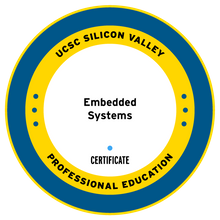Building the internet of things
This Program is Perfect For
- Hardware and IoT engineers seeking industry-grade design and prototyping skills
- Technologists aiming to understand both hardware and software in embedded environments
- Flexible learners pursuing a career-relevant credential with workforce or international approval
Courses
Program Requirements
Take 5–6 courses (14 quarter units).
- 3 required courses (8 quarter units)
- 2–3 elective credit courses (6 quarter units)
- End with certificate review.
1. Required Course(s):
- Flexible Attend in person or via Zoom at scheduled times.
| Date | Start Time | End Time | Meeting Type | Location |
|---|---|---|---|---|
| Wed, 01-21-2026 | 6:30pm | 9:30pm | Flexible | SANTA CLARA / REMOTE |
| Wed, 01-28-2026 | 6:30pm | 9:30pm | Flexible | SANTA CLARA / REMOTE |
| Wed, 02-04-2026 | 6:30pm | 9:30pm | Flexible | SANTA CLARA / REMOTE |
| Wed, 02-11-2026 | 6:30pm | 9:30pm | Flexible | SANTA CLARA / REMOTE |
| Wed, 02-18-2026 | 6:30pm | 9:30pm | Flexible | SANTA CLARA / REMOTE |
| Wed, 02-25-2026 | 6:30pm | 9:30pm | Flexible | SANTA CLARA / REMOTE |
| Wed, 03-04-2026 | 6:30pm | 9:30pm | Flexible | SANTA CLARA / REMOTE |
| Wed, 03-11-2026 | 6:30pm | 9:30pm | Flexible | SANTA CLARA / REMOTE |
This class meets simultaneously in a classroom and remotely via Zoom. Students are expected to attend and participate in the course, either in-person or remotely, during the days and times that are specified on the course schedule. Students attending remotely are also strongly encouraged to have their cameras on to get the most out of the remote learning experience. Students attending the class in-person are expected to bring a laptop to each class meeting.
To see all meeting dates, click "Full Schedule" below.
You will be granted access in Canvas to your course site and course materials approximately 24 hours prior to the published start date of the course.
Required Tools & Materials:
Students are required to purchase a hardware starter kit, a small board, breadboard, resistors, LED, and wires (estimated $45-60, not included in tuition) to do class projects on their laptops. These items should be purchased before the first class. For additional sensors or actuators depending on the student's interest, please contact the instructor
FREENOVE Ultimate Starter Kit for ESP32-S3-WROOM - FNK0082 ESP32-S3 Ultimate Kits, 36.5USD/PCS
Order via Amazon or at sale@freenove.com
- Flexible Attend in person or via Zoom at scheduled times.
| Date | Start Time | End Time | Meeting Type | Location |
|---|---|---|---|---|
| Thu, 01-08-2026 | 6:30pm | 9:30pm | Flexible | SANTA CLARA / REMOTE |
| Thu, 01-15-2026 | 6:30pm | 9:30pm | Flexible | SANTA CLARA / REMOTE |
| Thu, 01-22-2026 | 6:30pm | 9:30pm | Flexible | SANTA CLARA / REMOTE |
| Thu, 01-29-2026 | 6:30pm | 9:30pm | Flexible | SANTA CLARA / REMOTE |
| Thu, 02-05-2026 | 6:30pm | 9:30pm | Flexible | SANTA CLARA / REMOTE |
| Thu, 02-12-2026 | 6:30pm | 9:30pm | Flexible | SANTA CLARA / REMOTE |
| Thu, 02-19-2026 | 6:30pm | 9:30pm | Flexible | SANTA CLARA / REMOTE |
| Thu, 02-26-2026 | 6:30pm | 9:30pm | Flexible | SANTA CLARA / REMOTE |
| Thu, 03-05-2026 | 6:30pm | 9:30pm | Flexible | SANTA CLARA / REMOTE |
| Thu, 03-12-2026 | 6:30pm | 9:30pm | Flexible | SANTA CLARA / REMOTE |
| Thu, 03-19-2026 | 6:30pm | 9:30pm | Flexible | SANTA CLARA / REMOTE |
This class meets simultaneously in a classroom and remotely via Zoom. Students are expected to attend and participate in the course, either in-person or remotely, during the days and times that are specified on the course schedule. Students attending remotely are also strongly encouraged to have their cameras on to get the most out of the remote learning experience. Students attending the class in-person are expected to bring a laptop to each class meeting.
One “no meeting” TBA. To see all meeting dates, click "Full Schedule" below.
You will be granted access in Canvas to your course site and course materials approximately 24 hours prior to the published start date of the course.
Recommended Text:
Embedded Linux Primer: A Practical Real-World Approach, 2nd Edition, Christopher Hallinan, Prentice Hall, 2010, ISBN-10: 0137017839, ISBN-13: 978-0137017836.
- Flexible Attend in person or via Zoom at scheduled times.
| Date | Start Time | End Time | Meeting Type | Location |
|---|---|---|---|---|
| Mon, 03-30-2026 | 6:30pm | 9:30pm | Flexible | SANTA CLARA / REMOTE |
| Mon, 04-06-2026 | 6:30pm | 9:30pm | Flexible | SANTA CLARA / REMOTE |
| Mon, 04-13-2026 | 6:30pm | 9:30pm | Flexible | SANTA CLARA / REMOTE |
| Mon, 04-20-2026 | 6:30pm | 9:30pm | Flexible | SANTA CLARA / REMOTE |
| Mon, 04-27-2026 | 6:30pm | 9:30pm | Flexible | SANTA CLARA / REMOTE |
| Mon, 05-04-2026 | 6:30pm | 9:30pm | Flexible | SANTA CLARA / REMOTE |
| Mon, 05-11-2026 | 6:30pm | 9:30pm | Flexible | SANTA CLARA / REMOTE |
| Mon, 05-18-2026 | 6:30pm | 9:30pm | Flexible | SANTA CLARA / REMOTE |
| Mon, 06-01-2026 | 6:30pm | 9:30pm | Flexible | SANTA CLARA / REMOTE |
| Mon, 06-08-2026 | 6:30pm | 9:30pm | Flexible | SANTA CLARA / REMOTE |
This class meets simultaneously in a classroom and remotely via Zoom. Students are expected to attend and participate in the course, either in-person or remotely, during the days and times that are specified on the course schedule. Students attending remotely are also strongly encouraged to have their cameras on to get the most out of the remote learning experience. Students attending the class in-person are expected to bring a laptop to each class meeting.
No meeting May 25, 2026. To see all meeting dates, click "Full Schedule" below.
You will be granted access in Canvas to your course site and course materials approximately 24 hours prior to the published start date of the course.
Recommended Text:
Embedded Systems Architecture: A Comprehensive Guide for Engineers and Programmers, 2nd Edition, Tammy Noergaard, Newnes, 2012, ISBN-10: 0123821967, ISBN-13: 978-0123821966.
2. Electives: Embedded Software
- Flexible Attend in person or via Zoom at scheduled times.
| Date | Start Time | End Time | Meeting Type | Location |
|---|---|---|---|---|
| Fri, 01-23-2026 | 6:00pm | 9:00pm | Flexible | SANTA CLARA / REMOTE |
| Fri, 01-30-2026 | 6:00pm | 9:00pm | Flexible | SANTA CLARA / REMOTE |
| Fri, 02-06-2026 | 6:00pm | 9:00pm | Flexible | SANTA CLARA / REMOTE |
| Fri, 02-13-2026 | 6:00pm | 9:00pm | Flexible | SANTA CLARA / REMOTE |
| Fri, 02-20-2026 | 6:00pm | 9:00pm | Flexible | SANTA CLARA / REMOTE |
| Fri, 02-27-2026 | 6:00pm | 9:00pm | Flexible | SANTA CLARA / REMOTE |
| Fri, 03-06-2026 | 6:00pm | 9:00pm | Flexible | SANTA CLARA / REMOTE |
| Fri, 03-13-2026 | 6:00pm | 9:00pm | Flexible | SANTA CLARA / REMOTE |
This class meets simultaneously in a classroom and remotely via Zoom. Students are expected to attend and participate in the course, either in-person or remotely, during the days and times that are specified on the course schedule. Students attending remotely are also strongly encouraged to have their cameras on to get the most out of the remote learning experience. Students attending the class in-person are expected to bring a laptop to each class meeting.
To see all meeting dates, click "Full Schedule" below.
Electronic Course Materials: You will be granted access in Canvas to your course site and course materials approximately 24 hours prior to the published start date of the course.
Required Tools & Materials:
Development Board
Edition: OpenMV AE3
https://openmv.io/collections/cameras
An Edge AI device is required to follow this course, approximate cost $100. Choose either the OpenMV N6 or the OpenMV AE3. Both are capable of running advanced models such as YOLO.
An Edge AI device is required to follow this course, approximate cost $100: Chose either the OpenMV N6 or the OpenMV AE3. Both are capable of running advanced models such as YOLO.
- Flexible Attend in person or via Zoom at scheduled times.
| Date | Start Time | End Time | Meeting Type | Location |
|---|---|---|---|---|
| Thu, 04-09-2026 | 6:30pm | 9:30pm | Flexible | SANTA CLARA / REMOTE |
| Thu, 04-16-2026 | 6:30pm | 9:30pm | Flexible | SANTA CLARA / REMOTE |
| Thu, 04-23-2026 | 6:30pm | 9:30pm | Flexible | SANTA CLARA / REMOTE |
| Thu, 04-30-2026 | 6:30pm | 9:30pm | Flexible | SANTA CLARA / REMOTE |
| Thu, 05-07-2026 | 6:30pm | 9:30pm | Flexible | SANTA CLARA / REMOTE |
| Thu, 05-14-2026 | 6:30pm | 9:30pm | Flexible | SANTA CLARA / REMOTE |
| Thu, 05-21-2026 | 6:30pm | 9:30pm | Flexible | SANTA CLARA / REMOTE |
| Thu, 05-28-2026 | 6:30pm | 9:30pm | Flexible | SANTA CLARA / REMOTE |
| Thu, 06-04-2026 | 6:30pm | 9:30pm | Flexible | SANTA CLARA / REMOTE |
This class meets simultaneously in a classroom and remotely via Zoom. Students are expected to attend and participate in the course, either in-person or remotely, during the days and times that are specified on the course schedule. Students attending remotely are also strongly encouraged to have their cameras on to get the most out of the remote learning experience. Students attending the class in-person are expected to bring a laptop to each class meeting.
One "no meeting" TBA. To see all meeting dates, click "Full Schedule" below.
You will be granted access in Canvas to your course site and course materials approximately 24 hours prior to the published start date of the course.
Note: Students will need to purchase a development board for coursework. Below is a list of examples, approximate cost $100:
- Flexible Attend in person or via Zoom at scheduled times.
| Date | Start Time | End Time | Meeting Type | Location |
|---|---|---|---|---|
| Tue, 04-07-2026 | 6:30pm | 9:30pm | Flexible | SANTA CLARA / REMOTE |
| Tue, 04-14-2026 | 6:30pm | 9:30pm | Flexible | SANTA CLARA / REMOTE |
| Tue, 04-21-2026 | 6:30pm | 9:30pm | Flexible | SANTA CLARA / REMOTE |
| Tue, 04-28-2026 | 6:30pm | 9:30pm | Flexible | SANTA CLARA / REMOTE |
| Tue, 05-05-2026 | 6:30pm | 9:30pm | Flexible | SANTA CLARA / REMOTE |
| Tue, 05-12-2026 | 6:30pm | 9:30pm | Flexible | SANTA CLARA / REMOTE |
| Tue, 05-19-2026 | 6:30pm | 9:30pm | Flexible | SANTA CLARA / REMOTE |
| Tue, 05-26-2026 | 6:30pm | 9:30pm | Flexible | SANTA CLARA / REMOTE |
| Tue, 06-02-2026 | 6:30pm | 9:30pm | Flexible | SANTA CLARA / REMOTE |
| Tue, 06-09-2026 | 6:30pm | 9:30pm | Flexible | SANTA CLARA / REMOTE |
| Tue, 06-16-2026 | 6:30pm | 9:30pm | Flexible | SANTA CLARA / REMOTE |
| Tue, 06-23-2026 | 6:30pm | 9:30pm | Flexible | SANTA CLARA / REMOTE |
This class meets simultaneously in a classroom and remotely via Zoom. Students are expected to attend and participate in the course, either in-person or remotely, during the days and times that are specified on the course schedule. Students attending remotely are also strongly encouraged to have their cameras on to get the most out of the remote learning experience. Students attending the class in-person are expected to bring a laptop to each class meeting.
Two "no meetings" TBA. To see all meeting dates, click "Full Schedule" below.
You will be granted access in Canvas to your course site and course materials approximately 24 hours prior to the published start date of the course.
Required Tools & Materials: Need a Linux Host - either VM or native.
- Flexible Attend in person or via Zoom at scheduled times.
| Date | Start Time | End Time | Meeting Type | Location |
|---|---|---|---|---|
| Tue, 01-20-2026 | 6:30pm | 9:30pm | Flexible | SANTA CLARA / REMOTE |
| Tue, 01-27-2026 | 6:30pm | 9:30pm | Flexible | SANTA CLARA / REMOTE |
| Tue, 02-03-2026 | 6:30pm | 9:30pm | Flexible | SANTA CLARA / REMOTE |
| Tue, 02-10-2026 | 6:30pm | 9:30pm | Flexible | SANTA CLARA / REMOTE |
| Tue, 02-17-2026 | 6:30pm | 9:30pm | Flexible | SANTA CLARA / REMOTE |
| Tue, 02-24-2026 | 6:30pm | 9:30pm | Flexible | SANTA CLARA / REMOTE |
| Tue, 03-03-2026 | 6:30pm | 9:30pm | Flexible | SANTA CLARA / REMOTE |
| Tue, 03-10-2026 | 6:30pm | 9:30pm | Flexible | SANTA CLARA / REMOTE |
| Tue, 03-17-2026 | 6:30pm | 9:30pm | Flexible | SANTA CLARA / REMOTE |
| Tue, 03-24-2026 | 6:30pm | 9:30pm | Flexible | SANTA CLARA / REMOTE |
This class meets simultaneously in a classroom and remotely via Zoom. Students are expected to attend and participate in the course, either in-person or remotely, during the days and times that are specified on the course schedule. Students attending remotely are also strongly encouraged to have their cameras on to get the most out of the remote learning experience. Students attending the class in-person are expected to bring a laptop to each class meeting.
To see all meeting dates, click "Full Schedule" below.
You will be granted access in Canvas to your course site and course materials approximately 24 hours prior to the published start date of the course.
Recommended Texts:
Linux Device Drivers, 3rd Edition, Jonathan Corbet, et al., O'Reilly Media, 2005, ISBN-10: 0596005903, ISBN-13: 978-0596005900. Available Online: http://lwn.net/Kernel/LDD3/
Writing Linux Device Drivers: A Guide with Exercises, Jerry Cooperstein, CreateSpace Independent Publishing Platform, 2009, ISBN-10: 1448672384, ISBN-13: 978-1448672387.
Essential Linux Device Drivers, Sreekrishnan Venkateswaran, Prentice Hall, 2008, ISBN-10: 0132396556, ISBN-13: 978-0132396554.
- Flexible Attend in person or via Zoom at scheduled times.
| Date | Start Time | End Time | Meeting Type | Location |
|---|---|---|---|---|
| Fri, 04-03-2026 | 6:00pm | 9:00pm | Flexible | SANTA CLARA / REMOTE |
| Fri, 04-10-2026 | 6:00pm | 9:00pm | Flexible | SANTA CLARA / REMOTE |
| Fri, 04-17-2026 | 6:00pm | 9:00pm | Flexible | SANTA CLARA / REMOTE |
| Fri, 04-24-2026 | 6:00pm | 9:00pm | Flexible | SANTA CLARA / REMOTE |
| Fri, 05-01-2026 | 6:00pm | 9:00pm | Flexible | SANTA CLARA / REMOTE |
| Fri, 05-08-2026 | 6:00pm | 9:00pm | Flexible | SANTA CLARA / REMOTE |
| Fri, 05-15-2026 | 6:00pm | 9:00pm | Flexible | SANTA CLARA / REMOTE |
| Fri, 05-22-2026 | 6:00pm | 9:00pm | Flexible | SANTA CLARA / REMOTE |
| Fri, 05-29-2026 | 6:00pm | 9:00pm | Flexible | SANTA CLARA / REMOTE |
| Fri, 06-05-2026 | 6:00pm | 9:00pm | Flexible | SANTA CLARA / REMOTE |
| Fri, 06-12-2026 | 6:00pm | 9:00pm | Flexible | SANTA CLARA / REMOTE |
This class meets simultaneously in a classroom and remotely via Zoom. Students are expected to attend and participate in the course, either in-person or remotely, during the days and times that are specified on the course schedule. Students attending remotely are also strongly encouraged to have their cameras on to get the most out of the remote learning experience. Students attending the class in-person are expected to bring a laptop to each class meeting.
One “no meeting” TBA. To see all meeting dates, click "Full Schedule" below.
You will be granted access in Canvas to your course site and course materials approximately 24 hours prior to the published start date of the course.
Required Tools and Materials: Students are expected to install or have access to Linux Operating System version 7, or higher (version 9 is preferred) on their home computers.
Options include VMWare, VirtualBox, LiveCD, disk partition or separate drive or an embedded Linux system such as a Raspberry Pi.
- Flexible Attend in person or via Zoom at scheduled times.
| Date | Start Time | End Time | Meeting Type | Location |
|---|---|---|---|---|
| Mon, 01-05-2026 | 6:30pm | 9:30pm | Flexible | SANTA CLARA / REMOTE |
| Mon, 01-12-2026 | 6:30pm | 9:30pm | Flexible | SANTA CLARA / REMOTE |
| Mon, 01-26-2026 | 6:30pm | 9:30pm | Flexible | SANTA CLARA / REMOTE |
| Mon, 02-02-2026 | 6:30pm | 9:30pm | Flexible | SANTA CLARA / REMOTE |
| Mon, 02-09-2026 | 6:30pm | 9:30pm | Flexible | SANTA CLARA / REMOTE |
| Mon, 02-23-2026 | 6:30pm | 9:30pm | Flexible | SANTA CLARA / REMOTE |
| Mon, 03-02-2026 | 6:30pm | 9:30pm | Flexible | SANTA CLARA / REMOTE |
| Mon, 03-09-2026 | 6:30pm | 9:30pm | Flexible | SANTA CLARA / REMOTE |
| Mon, 03-16-2026 | 6:30pm | 9:30pm | Flexible | SANTA CLARA / REMOTE |
| Mon, 03-23-2026 | 6:30pm | 9:30pm | Flexible | SANTA CLARA / REMOTE |
This class meets simultaneously in a classroom and remotely via Zoom. Students are expected to attend and participate in the course, either in-person or remotely, during the days and times that are specified on the course schedule. Students attending remotely are also strongly encouraged to have their cameras on to get the most out of the remote learning experience. Students attending the class in-person are expected to bring a laptop to each class meeting.
No meetings on January 19 and February 16. To see all meeting dates, click "Full Schedule" below.
You will be granted access in Canvas to your course site and course materials approximately 24 hours prior to the published start date of the course.
- Live-Online Attend via Zoom at scheduled times.
| Date | Start Time | End Time | Meeting Type | Location |
|---|---|---|---|---|
| Tue, 03-31-2026 | 6:30pm | 9:30pm | Live-Online | REMOTE |
| Tue, 04-07-2026 | 6:30pm | 9:30pm | Live-Online | REMOTE |
| Tue, 04-14-2026 | 6:30pm | 9:30pm | Live-Online | REMOTE |
| Tue, 04-21-2026 | 6:30pm | 9:30pm | Live-Online | REMOTE |
| Tue, 04-28-2026 | 6:30pm | 9:30pm | Live-Online | REMOTE |
| Tue, 05-05-2026 | 6:30pm | 9:30pm | Live-Online | REMOTE |
| Tue, 05-12-2026 | 6:30pm | 9:30pm | Live-Online | REMOTE |
| Tue, 05-19-2026 | 6:30pm | 9:30pm | Live-Online | REMOTE |
| Tue, 05-26-2026 | 6:30pm | 9:30pm | Live-Online | REMOTE |
| Tue, 06-02-2026 | 6:30pm | 9:30pm | Live-Online | REMOTE |
This class is offered in an online synchronous format. Students are expected to log into this course via Canvas at the start time of scheduled meetings and participate via Zoom, for the duration of each scheduled class meeting.
To see all meeting dates, click "Full Schedule" below.
You will be granted access in Canvas to your course site and course materials approximately 24 hours prior to the published start date of the course.
3. Electives: Embedded Hardware
- Live-Online Attend via Zoom at scheduled times.
| Date | Start Time | End Time | Meeting Type | Location |
|---|---|---|---|---|
| Thu, 01-15-2026 | 6:30pm | 9:30pm | Live-Online | REMOTE |
| Thu, 01-22-2026 | 6:30pm | 9:30pm | Live-Online | REMOTE |
| Thu, 01-29-2026 | 6:30pm | 9:30pm | Live-Online | REMOTE |
| Thu, 02-05-2026 | 6:30pm | 9:30pm | Live-Online | REMOTE |
| Thu, 02-12-2026 | 6:30pm | 9:30pm | Live-Online | REMOTE |
| Thu, 02-19-2026 | 6:30pm | 9:30pm | Live-Online | REMOTE |
| Thu, 02-26-2026 | 6:30pm | 9:30pm | Live-Online | REMOTE |
| Thu, 03-05-2026 | 6:30pm | 9:30pm | Live-Online | REMOTE |
| Thu, 03-12-2026 | 6:30pm | 9:30pm | Live-Online | REMOTE |
| Thu, 03-19-2026 | 6:30pm | 9:30pm | Live-Online | REMOTE |
This class is offered in an online synchronous format. Students are expected to log into this course via Canvas at the start time of scheduled meetings and participate via Zoom, for the duration of each scheduled class meeting.
To see all meeting dates, click "Full Schedule" below.
You will be granted access in Canvas to your course site and course materials approximately 24 hours prior to the published start date of the course.
Required Tools & Materials: None
Recommended Tools & Materials:
Advanced Signal Integrity for High-Speed Digital Designs, Stephen H. Hall and Howard L. Heck, John Wiley & Sons, 2011, ISBN: 9781118210680.
Principles of Power Integrity for PDN Design - Simplified, Larry D. Smith and Eric Bogatin, Prentice Hall, 2017, ISBN: 9780132735629.
- Flexible Attend in person or via Zoom at scheduled times.
| Date | Start Time | End Time | Meeting Type | Location |
|---|---|---|---|---|
| Sat, 01-24-2026 | 8:30am | 12:30pm | Flexible | SANTA CLARA / REMOTE |
| Sat, 01-31-2026 | 8:30am | 12:30pm | Flexible | SANTA CLARA / REMOTE |
| Sat, 02-07-2026 | 8:30am | 12:30pm | Flexible | SANTA CLARA / REMOTE |
| Sat, 02-14-2026 | 8:30am | 12:30pm | Flexible | SANTA CLARA / REMOTE |
| Sat, 02-21-2026 | 8:30am | 12:30pm | Flexible | SANTA CLARA / REMOTE |
| Sat, 02-28-2026 | 8:30am | 12:30pm | Flexible | SANTA CLARA / REMOTE |
| Sat, 03-07-2026 | 8:30am | 12:30pm | Flexible | SANTA CLARA / REMOTE |
| Sat, 03-14-2026 | 8:30am | 12:30pm | Flexible | SANTA CLARA / REMOTE |
This class meets simultaneously in a classroom and remotely via Zoom. Students are expected to attend and participate in the course, either in-person or remotely, during the days and times that are specified on the course schedule. Students attending remotely are also strongly encouraged to have their cameras on to get the most out of the remote learning experience. Students attending the class in-person are expected to bring a laptop to each class meeting.
To see all meeting dates, click "Full Schedule" below.
You will be granted access in Canvas to your course site and course materials approximately 24 hours prior to the published start date of the course.
Required Tools & Materials: None
Recommended Tools & Materials:
Switching Power Supplies A-Z, Sanjaya Maniktala, 2012, Elsevier, ISBN: 9780123865335
Fundamentals of Power Electronics, Robert Erickson & Dragan Maksimovic, 3rd Ed., 2020, Springer, ISBN: 9783030438791
- Flexible Attend in person or via Zoom at scheduled times.
| Date | Start Time | End Time | Meeting Type | Location |
|---|---|---|---|---|
| Wed, 01-07-2026 | 6:30pm | 9:30pm | Flexible | SANTA CLARA / REMOTE |
| Wed, 01-14-2026 | 6:30pm | 9:30pm | Flexible | SANTA CLARA / REMOTE |
| Wed, 01-21-2026 | 6:30pm | 9:30pm | Flexible | SANTA CLARA / REMOTE |
| Wed, 01-28-2026 | 6:30pm | 9:30pm | Flexible | SANTA CLARA / REMOTE |
| Wed, 02-04-2026 | 6:30pm | 9:30pm | Flexible | SANTA CLARA / REMOTE |
| Wed, 02-11-2026 | 6:30pm | 9:30pm | Flexible | SANTA CLARA / REMOTE |
| Wed, 02-18-2026 | 6:30pm | 9:30pm | Flexible | SANTA CLARA / REMOTE |
| Wed, 02-25-2026 | 6:30pm | 9:30pm | Flexible | SANTA CLARA / REMOTE |
| Wed, 03-04-2026 | 6:30pm | 9:30pm | Flexible | SANTA CLARA / REMOTE |
| Wed, 03-11-2026 | 6:30pm | 9:30pm | Flexible | SANTA CLARA / REMOTE |
This class meets simultaneously in a classroom and remotely via Zoom. Students are expected to attend and participate in the course, either in-person or remotely, during the days and times that are specified on the course schedule. Students attending remotely are also strongly encouraged to have their cameras on to get the most out of the remote learning experience. Students attending the class in-person are expected to bring a laptop to each class meeting.
To see all meeting dates, click "Full Schedule" below.
You will be granted access in Canvas to your course site and course materials approximately 24 hours prior to the published start date of the course.
Required Text:
VHDL for Logic Synthesis, Authors: Andrew Rushton, Publisher: John Wiley & Sons, Publication Date: 2011-04-25, ISBN: 9780470688472
Recommended Texts:
The Verilog(R) Hardware Description Language, Authors: Donald Thomas, Philip Moorby, Publisher: Springer Science & Business Media, Publication Date: 2008-09-11, ISBN: 9780387853444
The Design Warrior's Guide to FPGAs, Authors: Clive Maxfield, Publisher: Elsevier, Publication Date: 2004-06-16, ISBN: 9780080477138
- Live-Online Attend via Zoom at scheduled times.
| Date | Start Time | End Time | Meeting Type | Location |
|---|---|---|---|---|
| Fri, 04-17-2026 | 6:30pm | 9:30pm | Live-Online | REMOTE |
| Fri, 04-24-2026 | 6:30pm | 9:30pm | Live-Online | REMOTE |
| Fri, 05-01-2026 | 6:30pm | 9:30pm | Live-Online | REMOTE |
| Fri, 05-08-2026 | 6:30pm | 9:30pm | Live-Online | REMOTE |
| Fri, 05-15-2026 | 6:30pm | 9:30pm | Live-Online | REMOTE |
This class is offered in an online synchronous format. Students are expected to log into this course via Canvas at the start time of scheduled meetings and participate via Zoom, for the duration of each scheduled class meeting.
To see all meeting dates, click "Full Schedule" below.
You will be granted access in Canvas to your course site and course materials approximately 24 hours prior to the published start date of the course.
Recommended Texts:
EMC for Product Designers; Tim Williams; Newnes, 2016. ISBN: 978-0081010143
Bogatin's Practical Guide to Transmission Line Design and Characterization for Signal Integrity; Eric Bogatin; Artech House, 2020. ISBN: 978-1-63081-851-7
EMC and the Printed Circuit Board: Design, Theory, and Layout Made Simple, Mark Montrose, Wiley/IEEE Press, ISBN-10: 078034703X, ISBN-13: 978-0780347038.
- Flexible Attend in person or via Zoom at scheduled times.
| Date | Start Time | End Time | Meeting Type | Location |
|---|---|---|---|---|
| Tue, 01-20-2026 | 6:30pm | 9:30pm | Flexible | SANTA CLARA / REMOTE |
| Tue, 01-27-2026 | 6:30pm | 9:30pm | Flexible | SANTA CLARA / REMOTE |
| Tue, 02-03-2026 | 6:30pm | 9:30pm | Flexible | SANTA CLARA / REMOTE |
| Tue, 02-10-2026 | 6:30pm | 9:30pm | Flexible | SANTA CLARA / REMOTE |
| Tue, 02-17-2026 | 6:30pm | 9:30pm | Flexible | SANTA CLARA / REMOTE |
| Tue, 02-24-2026 | 6:30pm | 9:30pm | Flexible | SANTA CLARA / REMOTE |
| Tue, 03-03-2026 | 6:30pm | 9:30pm | Flexible | SANTA CLARA / REMOTE |
| Tue, 03-10-2026 | 6:30pm | 9:30pm | Flexible | SANTA CLARA / REMOTE |
| Tue, 03-17-2026 | 6:30pm | 9:30pm | Flexible | SANTA CLARA / REMOTE |
| Tue, 03-24-2026 | 6:30pm | 9:30pm | Flexible | SANTA CLARA / REMOTE |
This class meets simultaneously in a classroom and remotely via Zoom. Students are expected to attend and participate in the course, either in-person or remotely, during the days and times that are specified on the course schedule. Students attending remotely are also strongly encouraged to have their cameras on to get the most out of the remote learning experience. Students attending the class in-person are expected to bring a laptop to each class meeting.
To see all meeting dates, click "Full Schedule" below.
You will be granted access in Canvas to your course site and course materials approximately 24 hours prior to the published start date of the course.
Recommended Texts:
The Design of CMOS Radio-Frequency Integrated Circuits; Thomas H. Lee; Cambridge University Press, 2004. ISBN: 9780521835398
Electronic Communication; Robert L. Shrader; McGraw-Hill Science, 1991.
The ARRL Handbook for Radio Amateurs 2000; American Radio Relay League; ARRL, 1999. ISBN: 9780872591837
4. Also of Interest
- Live-Online Attend via Zoom at scheduled times.
| Date | Start Time | End Time | Meeting Type | Location |
|---|---|---|---|---|
| Mon, 01-05-2026 | 6:30pm | 9:30pm | Live-Online | REMOTE |
| Mon, 01-12-2026 | 6:30pm | 9:30pm | Live-Online | REMOTE |
| Mon, 01-26-2026 | 6:30pm | 9:30pm | Live-Online | REMOTE |
| Mon, 02-02-2026 | 6:30pm | 9:30pm | Live-Online | REMOTE |
| Mon, 02-09-2026 | 6:30pm | 9:30pm | Live-Online | REMOTE |
| Mon, 02-23-2026 | 6:30pm | 9:30pm | Live-Online | REMOTE |
| Mon, 03-02-2026 | 6:30pm | 9:30pm | Live-Online | REMOTE |
| Mon, 03-09-2026 | 6:30pm | 9:30pm | Live-Online | REMOTE |
| Mon, 03-16-2026 | 6:30pm | 9:30pm | Live-Online | REMOTE |
| Mon, 03-23-2026 | 6:30pm | 9:30pm | Live-Online | REMOTE |
| Mon, 03-30-2026 | 6:30pm | 9:30pm | Live-Online | REMOTE |
This class is offered in an online synchronous format. Students are expected to log into this course via Canvas at the start time of scheduled meetings and participate via Zoom, for the duration of each scheduled class meeting.
No meetings on January 19 and February 16. To see all meeting dates, click "Full Schedule" below.
You will be granted access in Canvas to your course site and course materials approximately 24 hours prior to the published start date of the course.
Required Tools & Materials:
To participate in this class, you must have access to a computer (either a laptop or desktop) with the following system requirements:
Recommended System Requirements
Windows 11 (64-bit only) or Windows 10 (64-bit only)
Intel(R) Core(TM) i7 processor or equivalent
16GB RAM
10GB hard disk space (Install + User Files)
SSD
Adobe(R) Reader(R) (version XI or later for 3D PDF viewing)
Internet Connection
Web browser, which is up to date
Recommended Tools & Materials:
PCB Foundations, Paul B. Taubman and Sean Kelly, 2022, ISBN: 978-0998367095.
Practical PCB Design: A Hands-On Guide to Developing Printed Circuit Boards, Michael D. Smith, 2026, ISBN: 9781718504042.
Recommended System Requirements
Windows 11 (64-bit only) or Windows 10 (64-bit only)
Intel(R) Core(TM) i7 processor or equivalent
16GB RAM
10GB hard disk space (Install + User Files)
SSD
Adobe(R) Reader(R) (version XI or later for 3D PDF viewing)
Internet Connection
Web browser, which is up to date.
5. Completion Review:
Please enroll in the Embedded Systems Certificate Completion Fee only when all of the certificate requirements have been met and your final grades are posted.
Recommended course sequence
Requisite knowledge
You need a degree in a technical field or equivalent knowledge acquired through training and experience in system design and development. We recommended you have experience in C programming.
Please review course descriptions. Make sure you have taken the necessary prerequisites or meet the requirements through job experience or previous education before registering for a course.
Getting started
We suggest students begin with Embedded System Hardware Architectures, Introduction.
The remaining courses may be taken in any order provided prerequisites are met.
Substitutions & shared credits
Some technology courses may be listed in more than one program. However, only one course may be shared between two certificate programs unless otherwise noted.
Completion your certificate
Grade requirements
Please note that only letter grades of C or higher may be applied to a certificate, and in some programs, students may have more stringent requirements. Students in most employer- and government-sponsored payment programs, such as workforce development, as well as international students on F-1 visas, need to maintain a B average to meet their requirements.
See Grading and Credits Policy for further information.

Establish Candidacy
Instructors
Certificate Program Advisory Board
ALFREDO ALBA, MS
Senior Technical Staff Member, Intelligence Augmentation Department, IBM Almaden Research Center
ABDO BABUKR, MSEE
Consultant, Embedded Computing, Wave Spectrum, Inc.
SAM HUYNH, Ph.D.
Principal member of technical staff and a senior manager, AMD
Y.C. WANG, BSEE
Director, Global Academic Program at Digi-Key Electronics
Instructor, Embedded Systems Certificate Program, UCSC Silicon Valley Extension
MICHAEL A. WANG, M.S., M.B.A.
Director, Business Development, Silicon Motion Technology Corp.
Program Chair | Instructor, Embedded Systems Certificate Program, UCSC Silicon Valley Extension
































